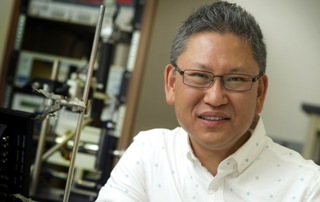Apr 10 2015
Seong Jin Koh, an associate professor in the Materials Science & Engineering Department at the University of Texas at Arlington, has been awarded a $300,000 grant by the National Science Foundation to build nanoscale pillars that may lead to the development of more energy-efficient transistors for applications in electronic gadgets and devices.
 Seong Jin Koh, associate professor of Materials Science and Engineering
Seong Jin Koh, associate professor of Materials Science and Engineering
This study may help reduce energy consumption in smart phones, tablets and laptops by ten times, which could lead to a similar reduction in charging frequency of the batteries suitable for those devices.
“The key is that all transistor components reside in a single nanopillar and that electrons flow through it without being heated,” said Koh, who added that a nanopillar is less than 50 nanometers in diameter. A human hair is about 100,000 nanometers thick. “This research will allow transistors to consume less energy and generate less heat. That greatly affects how well the transistors perform.”
The dean of the College of Engineering, Khosrow Behbehani, stated that apart from users of individual electronic components, other sectors would also achieve benefits.
“Soldiers who carry electronic gear on their missions could certainly lighten their load,” Behbehani said. “Creating these new energy-saving technologies has a truly positive effect on the world.”
For the last five years, Koh has been conducting studies, and this NSF grant would help continue his work.
Along with his team, Koh had found a method to cool electrons to a low temperature of -228°C without the application of any external means. This process was achieved at room temperature, and the discovery could allow electronic devices to operate using very little energy. The unique process discovered involves cooling of electrons by passing them through a quantum well so as to prevent them from getting heated.
“As the nanopillars are arranged vertically, extremely large number of transistors can be put on a small chip, but still function with very little energy”, said Koh.
This study has been published as a paper titled “Energy-filtered cold electron transport at room temperature,” in the September 2014 issue of Nature Communications journal.